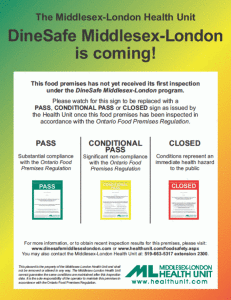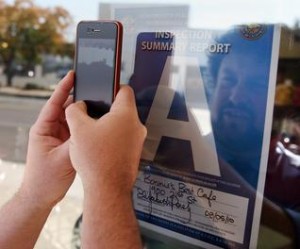In February 2010, Middlesex-London Health Unit (MLHU) launched its DineSafe website as a way to provide up-to-date information about the results of inspections conducted anywhere food is sold.
 Sean Meyer of London Community News writes that recently, the website was upgraded so it could indicate — in real time — the color of the DineSafe placard currently posted at restaurants, cafeterias, grocery and convenience stores across the city. The changes linked these two components of MLHU’s food inspection disclosure program.
Sean Meyer of London Community News writes that recently, the website was upgraded so it could indicate — in real time — the color of the DineSafe placard currently posted at restaurants, cafeterias, grocery and convenience stores across the city. The changes linked these two components of MLHU’s food inspection disclosure program.
While DineSafe functionality has increased, the data it is sharing is still generated by on-site inspections provided by the 12 public health inspectors working for MLHU’s food safety program.
David Pavletic has been with MLHU for 12 years, the first 10 as a public health inspector and the past couple as manager of environmental health.
Pavletic said he believes MLHU is doing a good job in making the inspection summaries available to the residents of London and Middlesex County.
“There is a lot of public interest expressed in having those inspection results made available,” Pavletic said. “Having the website and a very visible posting system at the food premises is serving that purpose of getting the information out.”
For the most part, Pavletic said, Middlesex and London have a high percentage of green pass signs. However, he adds that doesn’t mean people shouldn’t keep their eyes open.
“Just because there is a green pass sign it doesn’t mean everything is perfectly compliant,” Pavletic said. “There may be infractions noted when there is a green pass issued, the terminology we use is substantial compliance, but it doesn’t mean there was a perfect score.”
Visit the DineSafe website at www.healthunit.com/about-dinesafe for more information.










.jpeg)
 recordings of dancing mice, restaurant inspection grades, making people barf and hearing all about it.
recordings of dancing mice, restaurant inspection grades, making people barf and hearing all about it.